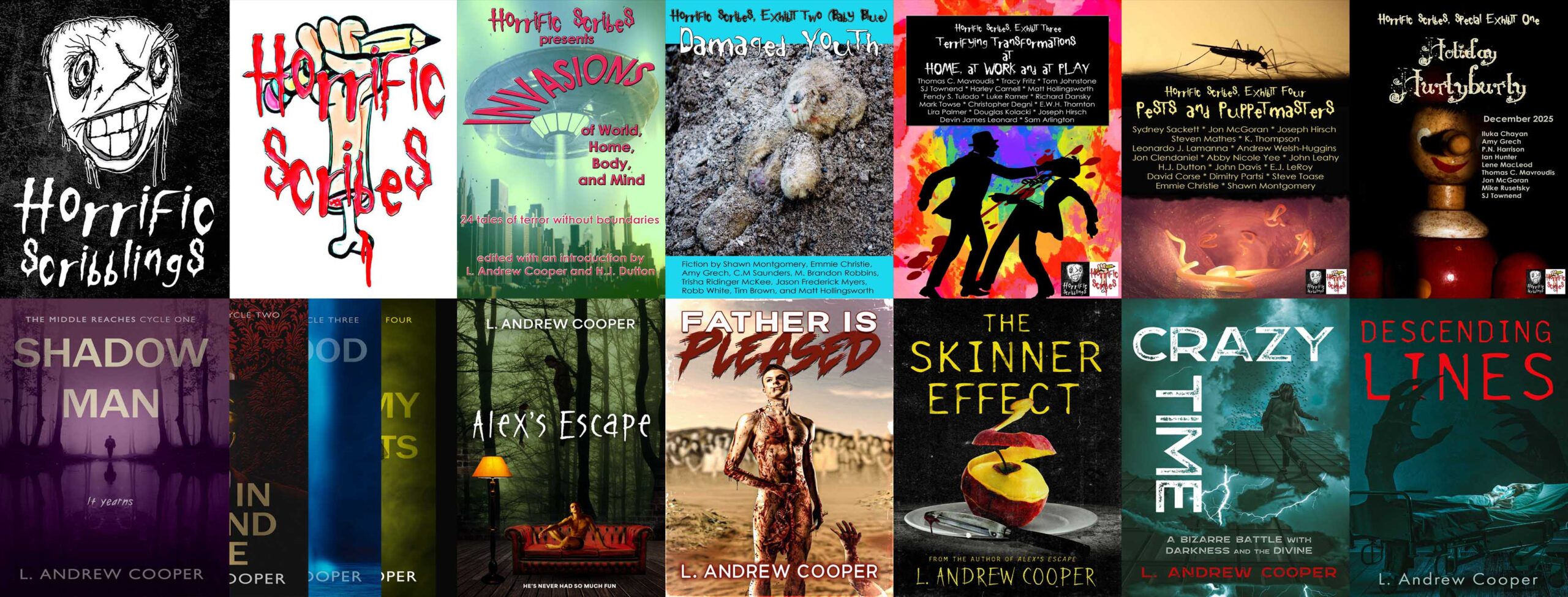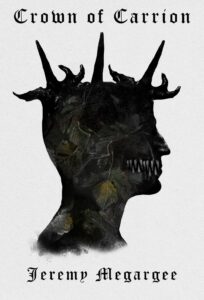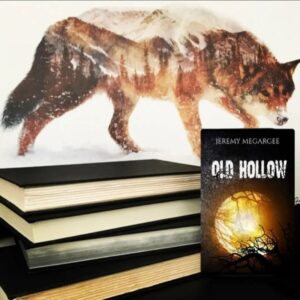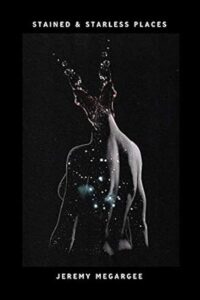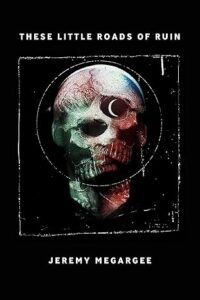Interview with Author Jeremy Megargee: Crown of Carrion and Soulmates (2024)
Jeremy Megargee displays serious storytelling skills in his forthcoming, very different novellas Crown of Carrion and Soulmates, into the depths of which we dive here.
Crown of Carrion
“A brutal novella involving werewolves, cannibalism, and zealotry.”
There’s a homestead deep in the mountains called Merkel Valley, and werewolves den there. They’re a peaceful clan, focused on hunting game animals and preserving the traditions of Mother Moon from one generation to the next.
But there’s unrest in the pack, and it comes in the form of a rogue wolf named Merrill Sade. He was banished long ago from Merkel Valley, but he has made his mark in the cities below with tooth and claw. He is a zealot obsessed with stories about an old feral god lost to time, and he has assembled a ragtag band of cannibals to serve at his heel. Merrill’s thoughts are rabid, and he has no qualms about wetting his fangs with innocent blood.
He seeks the remnants of a powerful relic known as the Crown of Carrion, and if found, they open a doorway to a ravenous force that howls across space and time. All that stands against him is his former lover Ivy and a few brave wolves from Merkel Valley that are willing to take a stand against Merrill’s unrepentant bloodshed.
Will peace prevail in Merkel Valley, or will Merrill and his cannibals feast on this world until nothing is left but gristle and dust?
Soulmates
“An intensely dark and toxic love story involving two lost souls finding one another in cyberspace.”
A tale that focuses on toxic love, mental illness, and the dangers of connections born in the most obscure corners of the internet.
Coming in November 2024!
The Interview
1. No Werewolf Dracula. I’m aware of werewolf fiction going back to the nineteenth century, and of course werewolves in legend and lore go back much, much further, but—unless you’re with Stephen King in thinking Stevenson’s Strange Case of Dr. Jekyll and Mr. Hyde (1886) is a werewolf story—literature has yet to give us a werewolf paragon comparable to the vampires’ Dracula (from the eponymous novel, 1897). Why do lycanthropes lack a spokeswolf? Would you nominate your rogue wolf Merrill Sade for the position? Why or why not? As monsters go, Merrill is more like Frankenstein’s Creature than Dracula because you give him a history of rejection and alienation. Do you want readers to sympathize with Merrill? Why or why not?
JM: I think it can be difficult to elevate a werewolf to that Dracula level because in essence, a werewolf is defined by duality. It’s almost like you’re dealing with two characters in one body. But that’s what has always made me gravitate in the direction of lycanthropes. They are flawed, they are at war with themselves, and at times there is a feeling of shame associated with their bestial nature. There’s something painfully human about that, isn’t there?
I’d love to see Merrill Sade claim that role in fiction, as a werewolf mainstay. He has accepted the animal that is inside of him. He clings to it. There is no shame in being what he is. I think in essence, Merrill tried and failed to be a person. All that remains is animal, and he finds pride and comfort in that.
And when it comes to Merrill being a sympathetic character, that is my sincere hope when readers dive into Crown. I want readers to see his pain, and perhaps relate to it. I gave him a history of rejection and alienation because, as the old adage goes, write what you know. I believe in leaning into vulnerability, and my own past is a crucible of childhood trauma. When you grow up a certain way, contending with emotional neglect, constant abuse, and a home environment that is the opposite of safe, it fundamentally changes how your brain perceives the world. It teaches you to distrust. It convinces you that happiness is not meant for you. When you encounter secure love, you can look and you can yearn, but it’s impossible to understand. It’s like feeling a soft touch when all you’ve ever known is teeth breaking your skin.
My own baseline is the expectation of rejection and alienation every single day of my life. Through therapy and taking ownership of my own mental health, I know that’s a completely false expectation. There is endless good in the world, and I’ve seen it. But that doesn’t change the foundation you were given in those pivotal moments of childhood that mattered the most. You expect the worst outcome. You anticipate the dark days. You taste pessimism because it’s familiar to your tongue. You must fight endlessly just to remind yourself that you deserve happiness, or love, or acceptance, just as every person on the planet does. That battle can make you weary sometimes.
I tried to imbue Merrill with all of those characteristics. He has been abandoned over and over. The people he always needed to show up for him never did. It has distorted his existence in some lasting way. He craves community, so he surrounds himself with shattered undesirables. He craves romantic love but cannot fathom how to maintain it. He makes bad decision after bad decision, and he never even sees that his path leads only to ruin.
He’s meant to be a character draped in tragedy.
2. The heroic she-wolf. Though werewolf literary standouts have been few, the lycanthrope has done much better in film, from The Wolf Man (1941) to An American Werewolf in London (1981) to the Underworld series (2003 – 2016?). A common feature of these films is male wolf leads: while notable she-wolves have appeared, making Ivy, a female, the leader in the force standing against Merrill is an unusual move. Why choose as she-wolf as your main protagonist? How would you describe her character? Will readers identify with her even though she’s technically a monster?
JM: I think that Ivy as a character is the total opposite of Merrill. Ivy is peace. Ivy nourishes herself and those close to her. She is quiet strength from beginning to end. When the novella starts, a heavy burden falls on her shoulders. She doesn’t shy away from it or shrug it off. She leans into the difficulty because she knows it will bring closure and comfort to a community that means everything to her. She has the makings of a leader even though she never asks for that role to be thrust upon her.
I think readers will see that her intentions come from a good place. She wants to protect, and she risks it all to do so.
3. Genre Transformations. There’s no denying readers get a heavy dose of horror with Crown of Carrion: people and werewolves tear apart, and often eat, other people and werewolves with alarming frequency. The book’s description uses the word “brutal.” Why the brutality? Though I don’t usually think of stories about classic creatures in this category, do you consider this book to be “extreme” or “hardcore” horror? Why or why not? Your story also has roots in fantasy/adventure. At the beginning, Ivy forms her party to go on a quest to confront Merrill, Merrill himself is on a quest to put together an ancient artifact, everyone’s on a difficult journey, etc. Why do you think you were drawn to these fantasy tropes? What influenced your genre blend? Might you have been influenced by role playing games—of the tabletop or video variety?
JM: I think the beautiful thing about literature today is that we are encouraged to experiment and navigate entirely new pathways. Blending genres so that the subject matter isn’t so easily defined. Crown has elements of extreme horror, some scenes of gore that will satiate anyone with a healthy literary bloodlust. But as you mentioned, there is also adventure, and questing, and two opposing forces that are destined to meet. And I think if anything in particular might have influenced those aspects of Crown, it would probably be the works of Jack London.
I grew up reading his novels and short stories, and I loved them. Stories of nature, harrowing journeys, and being pitted against the unforgiving wild. You can literally taste the frostbitten air of Alaska when you read London. He was a man who believed in writing what you know as well, and he lived all of those adventures that he wrote about. He traveled far, and he saw much. That’s a life of meaning without a doubt.
4. Religion and eldritch returns. Merrill’s quest is religious. It leads him away from the proper pack in Merkel Valley, which worships Mother Moon, to create a following of cannibals and gain both the Crown of Carrion and access to an old, feral god. Do you think Merrill’s religious rebellion and zealotry, along with the zealotry of his cannibal followers, have any resonance with real-world religious figures, groups, or struggles, historical or present? Why or why not? Involving old gods and powers that howl across space and time suggests a dimension of cosmic horror in this story—if that’s right, what does the cosmic add to the overall atmosphere and urgency of the tale? As I suggested in another recent interview, I can’t see the word “eldritch” without thinking Lovecraft, and the word comes up several times in your book… is there something Lovecraftian here?
JM: I could point out many different modern comparisons, but I think the core of zealotry was with us in the past, and it’ll pop up consistently in the future too. I’d liken it to a cult. There needs to be a larger-than-life force to believe in. There needs to be a charismatic soothsayer to spread the gospel and gather the herd. And behind it all, a promise of ascension. Merrill is Manson-like because he often influences others to kill for him.
I love a good bit of Lovecraft, but I think with Crown, I pulled more from another bygone master of cosmic horror. I’m a huge fan of Algernon Blackwood. His work stands the test of time, and it still howls loud and proud across the decades.
Blackwood made the Wilderness cosmic. He made the forest herself this interdimensional force that could not be easily defined. The trees invaders from the outer dark, the night wind some haunting whalesong across nameless galaxies. He reminded us that so much of our own world is unknown, terrifying, and much more cosmic than we ever give it credit for.
The old feral god in Crown of Carrion pulls from Blackwood’s darkest stories. Gargantuan claws scratching at the fabric of reality, just hoping for that single chance to puncture.
5. The return to nature and… cannibalism. Merrill’s world is very (pardon the pun) dog eat dog; his cannibal followers are as likely to eat one of their own as an outsider. Merrill seems to like their bestiality, however, and on several occasions muses that he wants the world to return to a more primal, animal state—a state of nature. This state of nature seems to be the one described by 17th century philosopher Thomas Hobbes, who thought humanity without civilization would be a war of all against all, and life would be “nasty, brutish, and short.” Do you think the view of a state of nature in Crown of Carrion is Hobbesian? Are all of Merrill’s ideas tainted by Merrill’s viciousness? Why or why not?
JM: That is such a cool observation, and I think Merrill would have loved the Hobbes philosophy. I think Merrill wants humans to return to a state of base animalism because that is all he knows. Merrill is intimately familiar with viciousness. He has felt it, and it makes him proficient at inflicting it. If all of humankind is pulled down into the blood and the muck with him, then he is no longer the outsider. He is not alone in his despair and his depravity. He can be that haunted wounded dog that he is, and he can watch every person on the planet learn to know what that feels like. He wants to normalize viciousness. Something twisted and feral, and most importantly, something that he understands.
I touch on that theme a lot in my older werewolf novel Old Hollow. There is a character in that book named Endre Calder, and he shares much of Merrill’s sentiments about embracing the animal within. And for a fun Easter egg for Old Hollow readers, Endre just might have been the great white wolf that sired Merrill Sade and turned him into what he is.
6. Dangerous Chemistry. Soulmates focuses on the development of the relationship between Ambrose, who suffers from Cotard’s delusion, which basically makes him believe he’s a walking corpse, and Dandelion, who likely suffers from an unnamed mental illness, difficult at least for this layman to pin down because she is in an almost perpetual state of trauma. What made you interested in Cotard’s delusion? What did you do for research? For Dandelion I thought maybe a borderline personality disorder… did you have a specific diagnosis or diagnoses in mind? Whatever their maladies, what makes the characters’ combination so “toxic” and yet, for each other, so potentially liberating?
JM: Phenomenal question, and I’ll answer by saying that I have something of an obsession with mental illness. I’m open about my own struggles with mental illness, so it has been a defining feature of my life, and I’m always aching to find the meaning in it. Cotard’s delusion is a particularly disturbing brain malady, and it has roots in the days when mental health institutions were barbaric in their treatments. It is the psychological belief that you are a walking cadaver. It stirs feelings of apathy, depression, and you lack a true sense of self. After all, if you’re dead, why try? In our introduction to Ambrose, we learn that living with it has severely impacted him. He’s in a sort of life stasis, and the events of the novella force him to confront that.
Spot on with Dandelion, too. I never had a specific mental illness in mind for her, but borderline personality disorder would fit her very well. I have friends who suffer from BPD, some of the most creative and passionate people I know, but I’ve also seen the depths of their suffering. It is often described as the emotional equivalent of having third degree burns. Dandelion loses herself in those depths often, and leviathans are always waiting to drag her deeper.
I think the two of them coming together is so potent because they are worlds apart. Ambrose is stoic, a lost nihilist, and Dandelion is a bloom of colorful chaos that appears in his life. They feed off each other. In essence, their love is parasitic.
7. Self-Harm. This subject comes up in Crown of Carrion as well: what does self-harm signify for you psychologically, and why is it prominent in your fiction? In Soulmates characters turn to self-harm for different reasons. Is either justified? Why or why not? Do your stories tend more often to justify or pathologize masochism? Why?
JM: I love this question because I’ve never really thought about where it comes from, but you’re right, self-harm is prevalent in my work. It bleeds up from the subconscious. In my youth, I struggled with self-destructive tendencies. I’d leap from planes and sky dive just to feel something. I’d crawl through cave passageways because it distracted me from the brain demons. I’d seek out the most feral sex, the most numbing activities, all of it a scream into the void, a middle finger to the void, as if to say, if this internal turmoil is my constant, I will find ways to release it.
There is the old adage “hurt people hurt people,” but speaking on a personal level, there is no one I’ve ever wanted to hurt other than myself. Through therapy I’ve left many of those self-destructive tendencies in the past, but they still bubble up on occasion. When they do, I have to put those feelings somewhere.
I put them in Merrill Sade. I put them in Ambrose. I put them in Dandelion. My characters can act as pain receptacles, and I suppose it’s a healthy way to practice masochism. You’ll find many of these same themes in my short fiction collections, Stained & Starless Places and These Little Roads of Ruin.
8. “His gore princess and his alone.” Ambrose and Dandelion both wonder a great deal about owning one another. For them, or for any of us, is there love without possession? Is there possession without objectification? What sets these characters up to experience such possessiveness? Is violence an expression of their romance—and how might violence in general be romantic?
JM: I think in the darkest realm of human emotion, we can be possessive. We can be territorial in the same way that animals are. We can crave and want and yearn, and one of the most volatile emotions to ever exist is passion. Men and women have died for passion. Cities have burned for passion. Wars have started in the name of passion. There is no greater hunt than the hunt for a heart that matches your own. Romance can be dangerous, because you risk all of yourself with the act.
9. Found chat-age. Records of Ambrose and Dandelion’s online chats compose much of the novella. How similar and how different are these “raw” moments from found footage in cinema? Should readers “see” anything but text during these moments? Are we supposed to distrust either character or favor either character’s implied perspective during the chats? What sort of commentary is Soulmates making about online dating, particularly in niche areas of online culture?
JM: I think I set so much of Soulmates in that limbo of cyberspace messaging because it has become a deeply rooted part of our modern culture. Often now, love is born online before it ever even translates over to real life. Because I focus on the more damaging parts of that in Soulmates, I think it’s a commentary on where we are as a society. We crave romantic love. It is taught in childhood through every form of media to crave that. And yet online dating is so dispassionate, this meat market of comparison and mindless swipes. Always seeking the next best option, never understanding the full weight of what makes a person a person aside from a few photos and a brief bio. There’s very little humanity in it. I think when you read articles or watch videos about young people in this generation’s dating scene, there are frequent comments on how demoralizing it is.
But then there are those rare moments when the universe aligns, and you find someone that is everything you’re looking for. That’s what happens with Ambrose and Dandelion. They look for love in all the wrong places, and they find it, and they proceed to celebrate their wrongness.
10. Access! How can readers learn more about you and your works (please provide any links you want to share)?
JM: I’m most active on Instagram; feel free to follow me at xbadmoonrising. My new books are releasing from Curious Corvid Publishing (on all social media platforms) so feel free to follow them too. You can find the majority of my novels and short stories on Amazon under the name Jeremy Megargee. I’m also active in several horror writer conventions on the east coast, including Scares That Care: Authorcon, so there’s a good chance you’ll see me out in the wild selling books sometime.
About the Author
Jeremy Megargee has always loved dark fiction. He cut his teeth on R.L Stine’s Goosebumps series as a child, and a fascination with Stephen King, Jack London, Algernon Blackwood, and many others followed later in life. Jeremy weaves his tales of personal horror from Martinsburg, West Virginia with his cat Lazarus acting as his muse/familiar. He is a native of Appalachia, and you can often find him peddling his dark words in various mountain hollers deep within the wilderness.
